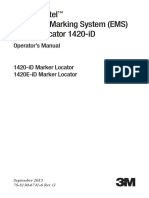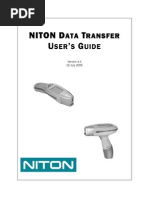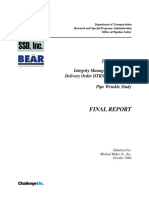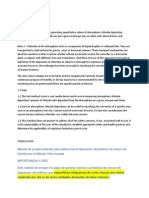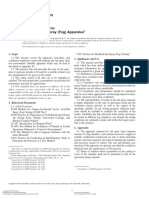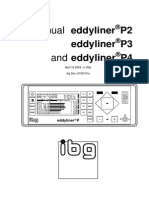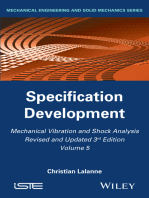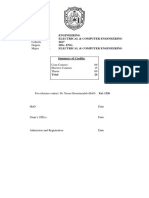Astm D 7046-04
Astm D 7046-04
Uploaded by
Pamela SanabriaCopyright:
Available Formats
Astm D 7046-04
Astm D 7046-04
Uploaded by
Pamela SanabriaOriginal Title
Copyright
Available Formats
Share this document
Did you find this document useful?
Is this content inappropriate?
Copyright:
Available Formats
Astm D 7046-04
Astm D 7046-04
Uploaded by
Pamela SanabriaCopyright:
Available Formats
Designation: D 7046 – 04
Standard Guide for
Use of the Metal Detection Method for Subsurface
Investigation1
This standard is issued under the fixed designation D 7046; the number immediately following the designation indicates the year of
original adoption or, in the case of revision, the year of last revision. A number in parentheses indicates the year of last reapproval. A
superscript epsilon (e) indicates an editorial change since the last revision or reapproval.
--``,``,`,``,,``,`,,,,`,,,,``-`-`,,`,,`,`,,`---
1. Scope 1.2.2 This guide is limited to metal detection measurements
1.1 Purpose and Application—This guide summarizes the made on land. The metal detection method can be adapted for
equipment, field procedures, and interpretation methods for the a number of special uses on land, water, airborne and ice.
assessment of subsurface materials using the metal detection 1.2.3 The approaches suggested in this guide for the metal
method. Metal detectors respond to the presence of both detection method are commonly used, widely accepted, and
ferrous and nonferrous metals by inducing eddy currents in proven. However, other approaches or modifications to the
conductive objects. Metal detectors are either frequency do- metal detection method that are technically sound may be
main (continuous frequency or wave) or time domain (pulsed) substituted.
systems. A wide range of metal detectors is commonly avail- 1.2.4 This guide offers an organized collection of informa-
able. tion or a series of options and does not recommend a specific
1.1.1 Metal detectors can detect any kind of metallic mate- course of action. This document cannot replace education,
rial, including both ferrous metals such as iron and steel, and experience and should be used in conjunction with professional
non-ferrous metals such as aluminum and copper. In contrast, judgment. Not all aspects of this guide may be applicable in all
magnetometers only detect ferrous metals. circumstances. This ASTM standard is not intended to repre-
1.1.2 Metal detector measurements can be used to detect the sent or replace the standard of care by which the adequacy of
presence of buried metal trash, drums (Tyagi et al, 1983) (1)2 a given professional service must be judged, nor should this
and tanks, abandoned wells (Guide D 6285); to trace buried document be applied without consideration of a project’s many
utilities; and to delineate the boundaries of landfill metal and unique aspects. The word “Standard” in the title of this
trench metal. They are also used to detect metal based document means only that the document has been approved
unexploded ordnance (UXO). through the ASTM consensus process.
1.1.3 Benson (1982) (2) and U.S. EPA (1993) (3) provide an 1.3 The values stated in SI units are regarded as standard.
overview of metal detectors. The values given in parentheses are inch-pound units, which
1.2 Limitations: are provided for information only and are not considered
1.2.1 This guide provides an overview of the metal detec- standard.
tion method. It does not provide or address the details of the 1.4 Precautions:
theory, field procedures, or interpretation of the data. Refer- 1.4.1 It is the responsibility of the user of this guide to
ences are included for that purpose and are considered an follow any precautions in the equipment manufacturer’s rec-
essential part of this guide. It is recommended that the user of ommendations and to establish appropriate health and safety
this guide be familiar with the references cited and with the practices.
ASTM standards D 420, D 653, D 5088, D 5608, D 5730, 1.4.2 If the method is used at sites with hazardous materials,
D 5753, D 6235, D 6429, and D 6431. operations, or equipment, it is the responsibility of the user of
this guide to establish appropriate safety and health practices
and to determine the applicability of any regulations prior to
1
This guide is under the jurisdiction of ASTM Committee D18 on Soil and Rock use.
and is the direct responsibility of Subcommittee D18.01.02 on Geophysics.
Current edition approved May 1, 2004. Published June 2004.
2
The boldface numbers in parentheses refer to the list of references at the end of
this standard.
Copyright © ASTM International, 100 Barr Harbor Drive, PO Box C700, West Conshohocken, PA 19428-2959, United States.
Copyright ASTM International 1
Reproduced by IHS under license with ASTM Licensee=malaysia-china hydro joint venture/5964027001
No reproduction or networking permitted without license from IHS Not for Resale, 01/05/2006 00:24:09 MST
D 7046 – 04
1.4.3 This standard does not purport to address all of the 4.2 Complementary Data—Data from other surface geo-
safety concerns, if any, associated with its use. It is the physical methods (see Guide D 6429) such as electromagnetics
responsibility of the user of this standard to establish appro- (Guides D 6639 and D 6820) and ground penetrating radar
priate safety and health practices and determine the applica- (Guide D 6432) may be useful in fully evaluating buried metal
bility of regulatory requirements prior to use. response. Geologic data obtained from other complementary
geological or surface geophysical methods (Guide D 6429) and
2. Referenced Documents borehole geophysical methods (Guide D 5753) may be neces-
2.1 ASTM Standards: 3 sary to help interpret and assess subsurface conditions.
--``,``,`,``,,``,`,,,,`,,,,``-`-`,,`,,`,`,,`---
D 420 Guide to Site Characterization for Engineering, De-
sign, and Construction Purposes 5. Significance and Use
D 653 Terminology relating to Soil, Rock, and Contained 5.1 Concepts:
Fluids 5.1.1 This guide summarizes the equipment, field proce-
D 3740 Practice for Minimum Requirements for Agencies dures, and interpretation methods for using the metal detection
Engaged in the Testing and/or Inspection of Soil and Rock method for locating subsurface metallic objects. Personnel
as Used in Engineering Design and Construction requirements are as discussed in Practice D 3740.
D 5088 Practice for the Decontamination of Field Equip-
5.1.2 Method—Metal detectors are electromagnetic instru-
ment Used at Nonradioactive Waste Sites
ments that work on the principle of induction, using typically
D 5608 Practice for the Decontamination of Field Equip-
two coils (antennas); a transmitter and a receiver. Both coils are
ment Used at Low Level Radioactive Waste Sites
fixed in respect to each other and are used near the surface of
D 5730 Guide to Site Characterization for Environmental
the earth. Either an alternating or a pulsed voltage is applied to
Purposes with Emphasis on Soil, Rock, the Vadose Zone
the transmitter coil causing electrical eddy currents to be
and Ground Water
induced in the earth. The electrical currents flowing in the earth
D 5753 Guide for Planning and Conducting Borehole Geo-
are proportional to electrical conductivity of the medium.
physical Logging
Theses currents generate eddy currents in buried metallic
D 6235 Guide for Expedited Site Characterization of Haz-
objects that is detected and measured by the receiver (Fig. 1).
ardous Waste Sites
D 6285 Guide for Locating Abandoned Wells 5.2 Parameter Measured and Representative Values:
D 6429 Guide for Selecting Surface Geophysical Methods 5.2.1 Frequency Domain Metal Detectors:
D 6431 Guide for Using the Direct Current Resistivity 5.2.1.1 Frequency domain metal detectors apply an alternat-
Method for Subsurface Investigation ing current having a fixed frequency and amplitude to the
D 6639 Guide for Using the Frequency Domain Electro- transmit coil which generates a time-varying magnetic field
magnetic Method for Subsurface Investigations around the coil. This field induces eddy currents in nearby
D 6820 Guide for Using the Time Domain Electromagnetic metallic objects that in turn generate time-varying magnetic
Method for Subsurface Investigations fields of their own. These eddy-fields induce a voltage in the
receiver coil. The presence of metal causes small changes in
3. Terminology the phase and amplitude of the receiver voltage. Most metal
3.1 Definitions—See Terminology D 653. The majority of detectors amplify the differences in the receiver coil voltage
the technical terms used in this document are defined in Sheriff caused by nearby metal and generate an audible sound or meter
(1991) (4), and Bates and Jackson (1997) (5). (analog or digital) reading.
5.2.1.2 Ground conductivity meters (frequency domain
4. Summary of Guide metal detectors) measure the two-components of the secondary
4.1 Summary of the Method—A metal detector uses either a magnetic field simultaneously. The first is the quadrature-phase
pulsed or an alternating current in a transmit coil to generate a component which indicates soil electrical conductivity and is
time varying magnetic field around the coil. This primary measured in millisiemens per meter (mS/m). The second is the
magnetic field induces eddy currents in buried metal which in inphase component, which is related to the subsurface mag-
turn, induces a voltage in a receiver coil, which, when netic susceptibility and is measured in parts per thousand (ppt)
amplified, reveal the presence of buried metal. (that is, the ratio between the primary and secondary magnetic
fields).
(1) Conductivity Measurements (Quadrature-Phase
Component)—Metallic objects within a few feet of the surface
3 will cause induced magnetic field distortions that will result in
For referenced ASTM standards, visit the ASTM website, www.astm.org, or
contact ASTM Customer Service at service@astm.org. For Annual Book of ASTM zero or even negative values of measured conductivity. Deeper
Standards volume information, refer to the standard’s Document Summary page on metallic objects will cause less field distortion and lead to
the ASTM website.
FIG. 1 Simplified Block Diagram of a Metal Detector System (Tyagi et al, 1983) (1)
Copyright ASTM International 2
Reproduced by IHS under license with ASTM Licensee=malaysia-china hydro joint venture/5964027001
No reproduction or networking permitted without license from IHS Not for Resale, 01/05/2006 00:24:09 MST
D 7046 – 04
measured conductivities which are abnormally high in com- 5.4.2 Limitations Specific to the Metal Detection Method:
parison to site background values. 5.4.2.1 Several factors influence metal detector response:
(2) Inphase Component—Inphase measurements are more the properties of the target, the properties of the soil/rock, and
sensitive to metal than conductivity measurements. Thus, the characteristics of the metal detector itself. The target’s size,
inphase anomalies may indicate the presence of metal at a depth, and condition of burial are the three most important
greater depth than the conductivity measurements. factors.
5.2.2 Time Domain Metal Detectors: 5.4.2.2 The larger the surface area of the target, the greater
5.2.2.1 In time domain metal detectors, a transmitter gener- the eddy current that may be induced, and the greater the depth
ates a pulsed primary magnetic field in the earth. After each at which the target may be detected.
pulse, secondary magnetic fields are induced briefly from 5.4.2.3 The metal detector’s response decreases at a rate
moderately conductive earth, and for a longer time from equal to the reciprocal of its depth up to the sixth power
metallic targets. Between each pulse, the metal detector waits (1/depth6). Therefore, if the distance to the target is doubled,
until the response from the conductive earth dissipates, and the metal detector response will decrease by a factor of 64.
then measures the prolonged buried metal response. This Consequently, the metal detector is a relatively shallow-depth
response is measured in millivolts (mV). device. It is generally restricted to detecting small objects at
5.3 Equipment—Metal detectors generally consist of trans- relatively shallow depths or larger targets at limited depths.
mitter electronics and transmitter coil, power supply, receiver Generally, most metal detectors are incapable of responding to
electronics and receiver coil. Metal detectors are usually single targets at depths much greater than 6 m.
individual portable. 5.4.2.4 Although the shape, orientation, and composition of
5.3.1 Typical “treasure-hunter” metal detectors provide an a target will influence the metal detector response, these factors
audible signal and/or meter reading (analog or digital) when will have much less influence than will the size and depth of
--``,``,`,``,,``,`,,,,`,,,,``-`-`,,`,,`,`,,`---
metal is detected. the target. Target deterioration, however, has a significant
5.3.2 Quadrature and inphase measurements from ground impact. Metallic containers will corrode in natural soils con-
conductivity meters are shown either on analog or digital ditions. If a container is corroded, its surface area will be
meters. These measurements can often be recorded digitally in significantly reduced, and in turn will degrade the response of
the field using a small field recorder, strip-chart recorder, or a metal detector.
computer. 5.4.2.5 Because the metal detector’s response weakens rap-
5.3.3 Time domain metal detectors can consist of either one idly with increasing distance to the target, system gain and
or two receiver coils. When two coils are used, one coil is instrument stability are important. The size of the coil controls
typically placed above the other. Readings from both coils are the size and depth of the metallic target that can be detected as
recorded simultaneously. In order to improve detection of shown in Fig. 2.
deeper metallic targets, the differential response from the two 5.4.3 Interferences Caused by Natural and Cultural Condi-
receiver coils can be used to suppress the response from tions:
smaller, shallower metallic targets. Some time domain metal 5.4.3.1 Sources of noise referred here do not include those
detectors are mounted on wheels, allowing for the use of of a physical nature such as difficult terrain or man-made
odometers to provide location data. obstructions but rather those of a geologic, ambient, or cultural
5.4 Limitations and Interferences: nature that can adversely affect the measurements and hence
5.4.1 General Limitations Inherent to Geophysical Meth- the interpretation.
ods: 5.4.3.2 Natural Sources of Noise—Some kinds of soil/rock,
5.4.1.1 A fundamental limitation of all geophysical methods particularly those containing high iron content (often known as
is that a given set of data cannot be associated with a unique set mineralized soil) affect receiver coil output strongly enough to
of subsurface conditions. In most situations, surface geophysi- indicate the presence of a metal target with certain kinds of
cal measurements alone cannot resolve all ambiguities, and metal detectors. Some types of metal detectors provide a means
some additional information, such as borehole data, is required. for compensating the output for the ground effect. This usually
Because of this inherent limitation in the geophysical methods, requires the operator to position the detector near the ground
a metal detector survey alone can never be considered a (but not near a metal target) and adjust a control until the target
complete assessment of subsurface conditions. Properly inte- signal disappears. Small variations in the soil characteristics
grated with other geologic information, metal detector survey- and stones (particularly those containing metallic compounds)
ing is a highly effective method of obtaining subsurface can cause small changes in the detector output. Often these
information. changes cause small target-like signals, known as “ground
5.4.1.2 In addition, all surface geophysical methods are noise.” These can confuse the operator because they sound like
inherently limited by decreasing resolution with depth. small targets.
NOTE—Data are shown for two metal detector coil sizes.
FIG. 2 Approximate Detection Ranges for Common Targets (Tyagi et al, 1983) (1)
Copyright ASTM International 3
Reproduced by IHS under license with ASTM Licensee=malaysia-china hydro joint venture/5964027001
No reproduction or networking permitted without license from IHS Not for Resale, 01/05/2006 00:24:09 MST
D 7046 – 04
5.4.3.3 Cultural Sources of Noise—Cultural sources of presence of noise-generating activities and operational con-
noise can include interference from electrical power lines, straints (which may restrict survey activities) must also be
communications equipment, nearby buildings, and metal considered. It is good practice to obtain as much of the relevant
fences. Interference from power lines is inversely proportional information as possible about the site prior to designing a
to the distance between power line and detector; therefore most survey and mobilization to the field. For example, data from
metal detectors with small coils are generally unaffected. any previous metal detection work, other surface geophysical
5.4.3.4 Surveys should not be made in close proximity to methods, boreholes, geologic and geophysical logs in the study
buildings, metal fences or buried metal pipe lines that can be area along with topographic maps or aerial photos should be
detected by the metal detection method, unless detection of the used to plan the survey.
buried pipe line, for example, is the object of the survey. It is 6.3 Survey Design—The main consideration affecting the
sometimes difficult to predict the appropriate distance from the survey design is the survey objective, which will generally
potential sources of noise. Measurements made on-site can determine the type of metal detector, the survey pattern, station
quickly yield the magnitude of the problem, and adjustments density, and the type and number of measurements needed.
can then be made. 6.3.1 There must be a clear technical objective to the metal
5.4.3.5 Precaution must also be taken to remove metal from detection survey. Target size, depth, and orientation, should be
the operator, or to minimize its effects. Steel-toe boots, estimated, as well as number and distribution of targets. It is
respirators, and air bottles can all cause considerable problems extremely important that the length of a profile line or area of
with noise. survey should be larger than the area of interest so that
5.5 Summary—During the course of designing and carrying sufficient measurements are taken in background conditions to
out a metal detection survey, the sources of ambient, geologic establish that any detected anomaly is indeed anomalous.
and cultural noise must be considered and the time of occur- 6.3.2 Instrument Selection—The instrument selected will
rence and location noted. The exact form of the interference is primarily depend on the depth of exploration required, type of
not always predictable, as it not only depends upon the type of data needed (qualitative or quantitative), and the survey objec-
noise and the magnitude of the noise but also upon the distance tives. This may mean selecting more than one metal detector to
from the source of noise and possibly the time of day. fulfill the project requirements.
5.6 Alternate Methods—In some cases, the factors dis- 6.3.3 Survey Geometry—Metal detection data may be ob-
cussed above may prevent the effective use of the metal tained randomly (for reconnaissance surveys), along a single
detection method, and other surface geophysical methods (see profile line, narrow or widely spaced profile lines, or over a
Guide D 6429) such as electromagnetics (Guides D 6639 and uniform grid. The station spacing will be determined by the
D 6820) or ground penetrating radar (Guide D 6432) or non- resolution required. Efforts should be made, if appropriate, to
geophysical methods may be required to investigate subsurface avoid biasing the data by taking many more measurements in
conditions. one direction than in another. The distance between station
6. Procedure measurements should be close enough to define the expected
anomaly. An anomaly must be defined by a minimum of 3
6.1 This section includes a discussion of personnel qualifi-
--``,``,`,``,,``,`,,,,`,,,,``-`-`,,`,,`,`,,`---
points and preferably by more points.
cation, considerations for planning and implementing the metal
6.3.4 Preliminary locations of survey lines are usually
detection survey, and interpretation of the data.
selected with the aid of topographic maps, aerial photos, and
6.1.1 Qualification of Personnel—Success of a metal detec-
site maps showing cultural interferences, such as buildings,
tion survey, as with most geophysical techniques, is dependent
fences, and power lines. Primary consideration to the location
upon many factors. One of the most important factors is the
and density of survey lines should be determined by the
competence of the person(s) responsible for planning, carrying
objectives of the survey.
out the survey, and interpreting the data. An understanding of
the theory, field procedures, and methods for interpretation of 6.3.5 In all cases, the survey line or areal coverage should
metal detection data along with an understanding of the site extend sufficiently beyond the target area to give good refer-
geology is necessary to successfully complete a survey. Per- ence to the normal background conditions.
sonnel not having specialized training or experience should be 6.4 Survey Implementation:
cautious about using this technique and solicit assistance from 6.4.1 On Site Check of Survey Plan—A systematic visual
qualified practitioners. inspection of the site should be made upon arrival to determine
6.2 Planning the Survey—Successful use of the surface if the initial survey plan is reasonable. At this point, modifi-
metal detection method depends to a great extent on careful cations to the survey plan may be required.
and detailed planning as discussed in this section. 6.4.2 Feasibility Test—Initial measurements should be
6.2.1 Objectives of the Metal Detection Survey—Planning made to assess the noise conditions at the site. Results of the
and design of a metal detection survey should be done with due initial measurements may require that changes be made to the
consideration to the objectives of the survey and the charac- original survey plan.
teristics of the site. These factors will determine the survey 6.4.3 Lay Out Survey Lines—Locate the best position for
design, the equipment used, the level of effort, the interpreta- the metal detector survey lines based on the survey design
tion method selected, and the budget necessary to achieve the described in 6.3 and the on-site conditions.
desired results. Important considerations include site geology, 6.4.3.1 For qualitative surveys, mark the location of metal-
desired depth of investigation, topography, and access. The lic anomalies on the ground and on a site map. For quantitative
Copyright ASTM International 4
Reproduced by IHS under license with ASTM Licensee=malaysia-china hydro joint venture/5964027001
No reproduction or networking permitted without license from IHS Not for Resale, 01/05/2006 00:24:09 MST
D 7046 – 04
surveys, mark station locations on the ground and on a site map preter applies his knowledge of the site, what he expects to find
or, if continuous measurements are being recorded, mark and what the target is expected to look like if detected.
stations for fiducial markings. The fiducial marks will help to 6.5.3.5 Estimation of Target Depth—An approximation of
reduce the measurements to spatially oriented measurements target depth can be made with data from time domain metal
with a minimum of error. Variations in walking or vehicle detectors having a lower and upper receiver coil. The apparent
speed will result in positioning errors, which are corrected for depth approximation is most accurate when the instrument is
each time a fiducial mark is recorded. The closer the fiducial positioned over the center of the buried target. The accuracy of
marks, the smaller the spatial error. the approximation will depend on the relation between the line
6.4.3.2 A Differential Global Positioning System (DGPS) (station) and center of the target, the size and shape of the
can be used to locate the position of each target or measure- target, as well as on the quality of the data.
ment within the error specified for the DGPS. 6.6 Quality Control (QC)—Quality control can be appropri-
6.5 Interpretation: ately applied to metal detection measurements and are appli-
6.5.1 The level of effort involved in the interpretation cable to the field procedures, processing and interpretation
depends upon the objectives of the survey, the type of phases of the survey. Good quality control requires that
instrument used, and the detail desired. standard procedures are followed and appropriate documenta-
6.5.1.1 A problem inherent in all geophysical studies is the tion made.
nonunique correlation between possible subsurface models and 6.6.1 Calibration and Standardization—In general, the
a single set of field data. This ambiguity can only be resolved manufacturer’s recommendation should be followed for cali-
through the use of geologic, geophysical, and other available bration and standardization. If no such recommendations are
information along with the experience of the interpreter. provided, a routine check of equipment should be made on a
6.5.1.2 Any preliminary interpretation should be treated periodic basis and after each problem and repair. A operational
with caution. Preliminary analysis done in the field is mostly a check of equipment along with a test measurement made in a
means of quality control. background or test area should be carried out before each
6.5.2 Qualitative Surveys: project and before the start of a new project and before starting
6.5.2.1 Most frequency domain metal detectors have both fieldwork each day.
audio and meter indicators, with no provision for directly 6.6.2 Survey Procedure—The use of Differential Global
recording the information output. Reconnaissance-level sur- Positioning Systems (DGPS) or accurate surveying systems
veys with relatively simple site conditions can be handled can sometimes significantly improve the quality of the survey.
effectively with these instruments. DGPS are relatively easy to use and generally cost effective
and they can provide survey locations that are operator
6.5.2.2 Metal detector responses or target locations can be
independent. Any follow-up survey required can then be
noted in a field log, or on a site map. Stakes or paint marks can
simply and accurately located with respect to the original
be placed over target centers or around their boundaries as the
survey.
survey proceeds. These types of metal detector results are
6.6.3 Field procedure QC should include:
generally self-evident, and further analysis and processing are
6.6.3.1 Documentation of anomaly location, survey grid or
unnecessary.
station layout and measurements to be taken.
6.5.3 Quantitative Surveys: 6.6.3.2 Documentation of any changes to the planned field
6.5.3.1 The output from some frequency domain metal procedure due to previously unknown site conditions (man-
detectors and most time domain metal detectors can be made and natural).
digitally recorded in the field. Some older instruments use strip 6.6.3.3 Any other conditions possibly affecting the survey
chart recorders or magnetic tape to record data in the field. and measurements including topography, obstacles, weather
Such recorded data is useful when site conditions are complex conditions, and nearest power lines should be recorded.
such as when mapping the boundaries of metal in randomly- 6.6.3.4 Profile or grid data should be plotted immediately
--``,``,`,``,,``,`,,,,`,,,,``-`-`,,`,,`,`,,`---
oriented trenches and buried pits. after data acquisition to ensure that the data is of adequate
6.5.3.2 Data processing such as filtering can be applied to quality and quantity to define survey objectives.
recorded data to remove high-frequency noise from small local 6.6.3.5 Documentation of any problem with the equipment;
targets. what steps were taken to correct the problem, and how the
6.5.3.3 Profiling with metal detectors is most often used for problem could affect the data.
locating anomalies such as pipes, tanks, or trenches. These are 6.6.3.6 Establish and revisit nearby base station background
generally detected by a measurement signature characteristic of or test area on a periodic basis.
the anomaly and can be interpreted by visually inspecting the
plotted profile data. 7. Quality Assurance
6.5.3.4 Surveys taken in a grid fashion are usually intended 7.1 It is generally good practice to have the entire survey
to map the lateral extent of some feature such as a buried results, including the report, reviewed by a person knowledge-
disposal site or a site with buried tanks and piping. They can able with the TDEM/TEM method and the site geology, but not
also be high-resolution surveys looking for small buried directly involved with the project.
objects such as in an archeological or forensic investigation. In
either case, the data are plotted and contoured and interpreted 8. Report
visually by geometric patterns on signal contrasts. The inter- 8.1 Components of the Report:
Copyright ASTM International 5
Reproduced by IHS under license with ASTM Licensee=malaysia-china hydro joint venture/5964027001
No reproduction or networking permitted without license from IHS Not for Resale, 01/05/2006 00:24:09 MST
D 7046 – 04
8.1.1 The following is a list of the key items that should be objectives may be set depending on the purposes of the survey
contained in most reports. In some cases there may be no need and on site conditions.
for an extensive formal report. A report that meets or follows 9.2 Bias—For the purposes of this guide, bias is defined as
an organization’s specific requirements can be substituted as a measure of the closeness to the truth.
long as the following items are included. 9.2.1 Some of the factors that affect bias are:
8.1.2 The report should include a discussion of: 9.2.1.1 Errors in field procedures, record-keeping, correc-
8.1.2.1 The purpose and scope of the survey, tions to data, processing and interpretation,
8.1.2.2 The geologic setting, 9.2.1.2 Instrument errors in measuring or recording,
8.1.2.3 Any limitations of the survey, 9.2.1.3 Geometry limitations, relating to line location and
8.1.2.4 Any assumptions that were made, topography,
9.2.1.4 Variation of the earth from simplifying assumptions
8.1.2.5 The field approach used, including a description of
used in the field and interpretation procedure,
the equipment and the data acquisition parameters used,
9.2.1.5 Site-specific geologic limitations, such as ambient
8.1.2.6 The location of metallic anomalies, or the location
radiated or induced noise, or the presence of buried conductors,
of survey line(s) or grid along with a site map,
9.2.1.6 Ability and experience of the field crew, data pro-
8.1.2.7 Any corrections applied to field data, along with cessor and interpreter, and
justification for their use, 9.2.1.7 Operator bias for small anomalies at or near the
8.1.2.8 The results of field measurements, noise level of the equipment and setting, particularly on data
8.1.2.9 Copies of typical raw data and mechanism for sets that are not digitally recorded.
obtaining all data, 9.3 Resolution:
8.1.2.10 The format of recorded data, 9.3.1 Lateral Resolution—Lateral resolution for the metal
8.1.2.11 Copies of the processed profiles and/or contours, detector method is primarily dependent on the coil geometry,
8.1.2.12 The method of interpretation used and specifically target depth and size, and the measurement spacing. Instru-
what analytical method(s) or software program(s) were used, ments with smaller coils provide better resolution for a
8.1.2.13 The interpreted results along with any qualifica- shallower depth. Resolution can be improved by decreasing the
--``,``,`,``,,``,`,,,,`,,,,``-`-`,,`,,`,`,,`---
tions and alternate interpretations, station separation. Decreasing the line spacing will always
8.1.2.14 If conditions occurred where a variance from this provide more information on target location and size.
guide is necessary, the reason for the variance should be given, 9.3.2 Vertical Resolution—Vertical resolution for the metal
8.1.2.15 Appropriate supporting data or references used in detector method is defined as how small a change in depth can
the interpretation, and be detected. In general, the most that can be expected from the
8.1.2.16 Persons responsible for the survey and data inter- metal detector method is an approximation. The accuracy of
pretation. the approximation will depend on the relation between the line
(station) and center of the target, the size and shape of the
9. Precision and Bias target, as well as on the quality of the data.
9.1 Precision—Precision is the repeatability between mea- 10. Keywords
surements. If a metal detector measurement is repeated under 10.1 frequency domain; geophysics; metal detection; metal
identical conditions with low noise levels, the measurements detector; subsurface investigation; surface geophysics; time
would be expected to be within 2 to 3 %. Different data quality domain
REFERENCES
(1) Tyagi, S., Lord, A. E., Jr., and Koerner, R. M., “Use of a Metal (3) U.S. Environmental Protection Agency, Use of Airborne, Surface and
Detector to Detect Buried Drums in Sandy Soil,” Journal of Hazard- Borehole Geophysical Techniques at Contaminated Sites, A Reference
ous Materials, Vol 7, 1983, pp. 375-381. Guide, EPA/625/R-92/007, 1993.
(2) Benson, R., Glaccum, R. A., and Noel, M. R., Geophysical Techniques (4) Sheriff, Robert E., Encyclopedic Dictionary of Exploration Geophys-
for Sensing Buried Wastes and Waste Migration, Office of Research ics, 3rd edition, Soc. Expl. Geophysics, Tulsa, OK, 1991, p. 376.
and Development, U.S. Environmental Protection Agency, Las Vegas, (5) Bates, R. L., and Jackson, J. A., Glossary of Geology, 4th edition,
Nevada, 1982. American Geological Institute, 1997.
ASTM International takes no position respecting the validity of any patent rights asserted in connection with any item mentioned
in this standard. Users of this standard are expressly advised that determination of the validity of any such patent rights, and the risk
of infringement of such rights, are entirely their own responsibility.
This standard is subject to revision at any time by the responsible technical committee and must be reviewed every five years and
if not revised, either reapproved or withdrawn. Your comments are invited either for revision of this standard or for additional standards
and should be addressed to ASTM International Headquarters. Your comments will receive careful consideration at a meeting of the
responsible technical committee, which you may attend. If you feel that your comments have not received a fair hearing you should
make your views known to the ASTM Committee on Standards, at the address shown below.
Copyright ASTM International 6
Reproduced by IHS under license with ASTM Licensee=malaysia-china hydro joint venture/5964027001
No reproduction or networking permitted without license from IHS Not for Resale, 01/05/2006 00:24:09 MST
D 7046 – 04
This standard is copyrighted by ASTM International, 100 Barr Harbor Drive, PO Box C700, West Conshohocken, PA 19428-2959,
United States. Individual reprints (single or multiple copies) of this standard may be obtained by contacting ASTM at the above
address or at 610-832-9585 (phone), 610-832-9555 (fax), or service@astm.org (e-mail); or through the ASTM website
(www.astm.org).
--``,``,`,``,,``,`,,,,`,,,,``-`-`,,`,,`,`,,`---
Copyright ASTM International 7
Reproduced by IHS under license with ASTM Licensee=malaysia-china hydro joint venture/5964027001
No reproduction or networking permitted without license from IHS Not for Resale, 01/05/2006 00:24:09 MST
You might also like
- Guideline For Determination of Particle Size Distribution: ScopeNo ratings yetGuideline For Determination of Particle Size Distribution: Scope2 pages
- Accuload Ii - Rbu: Electronic Preset ControllerNo ratings yetAccuload Ii - Rbu: Electronic Preset Controller197 pages
- OIML R 80-2: Nternational EcommendationNo ratings yetOIML R 80-2: Nternational Ecommendation48 pages
- FM Global Property Loss Prevention Data Sheets: List of FiguresNo ratings yetFM Global Property Loss Prevention Data Sheets: List of Figures11 pages
- Testing The Resolution of A Raman SpectrometerNo ratings yetTesting The Resolution of A Raman Spectrometer5 pages
- GWC Italia: Proven Technology For Individual Valve Solutions WorldwideNo ratings yetGWC Italia: Proven Technology For Individual Valve Solutions Worldwide19 pages
- FGL Distribution 2016 Asset Management PlanNo ratings yetFGL Distribution 2016 Asset Management Plan195 pages
- Minutes Asme MFC Standards Committee Measurement of Fluid Flow in Closed Conduits APRIL 27, 2017 8:00 AM - 12:00 PMNo ratings yetMinutes Asme MFC Standards Committee Measurement of Fluid Flow in Closed Conduits APRIL 27, 2017 8:00 AM - 12:00 PM45 pages
- Ministry of Defence Defence Standard 00-44: Issue 1 Publication Date 31 January 2007No ratings yetMinistry of Defence Defence Standard 00-44: Issue 1 Publication Date 31 January 200750 pages
- 2001 Standard For: Air Diffusers and Air Diffuser AssembliesNo ratings yet2001 Standard For: Air Diffusers and Air Diffuser Assemblies9 pages
- MS-ISO 14021 2016E-Character PDF Document PREVIEWNo ratings yetMS-ISO 14021 2016E-Character PDF Document PREVIEW7 pages
- English / Spanish Version Versión en Inglés y EspañolNo ratings yetEnglish / Spanish Version Versión en Inglés y Español21 pages
- Mechanical Vibration and Shock Analysis, Specification DevelopmentFrom EverandMechanical Vibration and Shock Analysis, Specification DevelopmentNo ratings yet
- NB 1225001-2 Hormigón Estructural Parte 2No ratings yetNB 1225001-2 Hormigón Estructural Parte 2439 pages
- EFNARC-Test Method For Tenacity and Residual StrengthNo ratings yetEFNARC-Test Method For Tenacity and Residual Strength48 pages
- XENSIV™ - SP40+: Tire Pressure Monitoring Sensors (TPMS)No ratings yetXENSIV™ - SP40+: Tire Pressure Monitoring Sensors (TPMS)2 pages
- Pressure Sensors For Industrial Applications Model P3297: Description FeaturesNo ratings yetPressure Sensors For Industrial Applications Model P3297: Description Features4 pages
- Lecture Notes Set 1 - Introduction To Mechatronics System DesignNo ratings yetLecture Notes Set 1 - Introduction To Mechatronics System Design16 pages
- Automotive Electronics Automotive Electronics Product Information Evaluation Circuit For Sensor Impedance Ratios - CC215No ratings yetAutomotive Electronics Automotive Electronics Product Information Evaluation Circuit For Sensor Impedance Ratios - CC2152 pages
- 05 - PA - MDPS (Motor Driven Power Steering)No ratings yet05 - PA - MDPS (Motor Driven Power Steering)13 pages
- Electric Coils For Single Duct TerminalsNo ratings yetElectric Coils For Single Duct Terminals7 pages
- Lecure-1 Introduction To Biomedical Instrumentation System - 480% (5)Lecure-1 Introduction To Biomedical Instrumentation System - 441 pages
- Infineon SP400 15 11 DataSheet v01 - 01 ENNo ratings yetInfineon SP400 15 11 DataSheet v01 - 01 EN71 pages
- Arduino-Based System For Soil Moisture Measurement: February 2017No ratings yetArduino-Based System For Soil Moisture Measurement: February 20175 pages
- Ultrasonic Wind Speed and Direction SensorNo ratings yetUltrasonic Wind Speed and Direction Sensor6 pages
- Biomimetics For NASA Langley Research Center Year 2000 Report of Findings From A Six-Month SurveyNo ratings yetBiomimetics For NASA Langley Research Center Year 2000 Report of Findings From A Six-Month Survey95 pages
- QTouch Modular Library PTC UG DS40001986ENo ratings yetQTouch Modular Library PTC UG DS40001986E100 pages
- Overview of Automotive Sensors: William J. FlemingNo ratings yetOverview of Automotive Sensors: William J. Fleming13 pages
- Improved BMS A Smart Electric Vehicle Design Based On An Intelligent Battery Management SystemNo ratings yetImproved BMS A Smart Electric Vehicle Design Based On An Intelligent Battery Management System8 pages
- I-9102 Intelligent Photoelectric Smoke Detector Issue1.03No ratings yetI-9102 Intelligent Photoelectric Smoke Detector Issue1.032 pages
- Compact GSM II: Installation and Application ManualNo ratings yetCompact GSM II: Installation and Application Manual21 pages
- College: Department: Cohorts: Degree: MajorNo ratings yetCollege: Department: Cohorts: Degree: Major5 pages
- Design and Construction of A GSM Based GNo ratings yetDesign and Construction of A GSM Based G6 pages
- Frederick National Laboratory For Cancer Research, Frederick, MDNo ratings yetFrederick National Laboratory For Cancer Research, Frederick, MD14 pages
- Guideline For Determination of Particle Size Distribution: ScopeGuideline For Determination of Particle Size Distribution: Scope
- FM Global Property Loss Prevention Data Sheets: List of FiguresFM Global Property Loss Prevention Data Sheets: List of Figures
- GWC Italia: Proven Technology For Individual Valve Solutions WorldwideGWC Italia: Proven Technology For Individual Valve Solutions Worldwide
- Minutes Asme MFC Standards Committee Measurement of Fluid Flow in Closed Conduits APRIL 27, 2017 8:00 AM - 12:00 PMMinutes Asme MFC Standards Committee Measurement of Fluid Flow in Closed Conduits APRIL 27, 2017 8:00 AM - 12:00 PM
- Ministry of Defence Defence Standard 00-44: Issue 1 Publication Date 31 January 2007Ministry of Defence Defence Standard 00-44: Issue 1 Publication Date 31 January 2007
- 2001 Standard For: Air Diffusers and Air Diffuser Assemblies2001 Standard For: Air Diffusers and Air Diffuser Assemblies
- English / Spanish Version Versión en Inglés y EspañolEnglish / Spanish Version Versión en Inglés y Español
- Mechanical Vibration and Shock Analysis, Specification DevelopmentFrom EverandMechanical Vibration and Shock Analysis, Specification Development
- EFNARC-Test Method For Tenacity and Residual StrengthEFNARC-Test Method For Tenacity and Residual Strength
- XENSIV™ - SP40+: Tire Pressure Monitoring Sensors (TPMS)XENSIV™ - SP40+: Tire Pressure Monitoring Sensors (TPMS)
- Pressure Sensors For Industrial Applications Model P3297: Description FeaturesPressure Sensors For Industrial Applications Model P3297: Description Features
- Lecture Notes Set 1 - Introduction To Mechatronics System DesignLecture Notes Set 1 - Introduction To Mechatronics System Design
- Automotive Electronics Automotive Electronics Product Information Evaluation Circuit For Sensor Impedance Ratios - CC215Automotive Electronics Automotive Electronics Product Information Evaluation Circuit For Sensor Impedance Ratios - CC215
- Lecure-1 Introduction To Biomedical Instrumentation System - 4Lecure-1 Introduction To Biomedical Instrumentation System - 4
- Arduino-Based System For Soil Moisture Measurement: February 2017Arduino-Based System For Soil Moisture Measurement: February 2017
- Biomimetics For NASA Langley Research Center Year 2000 Report of Findings From A Six-Month SurveyBiomimetics For NASA Langley Research Center Year 2000 Report of Findings From A Six-Month Survey
- Overview of Automotive Sensors: William J. FlemingOverview of Automotive Sensors: William J. Fleming
- Improved BMS A Smart Electric Vehicle Design Based On An Intelligent Battery Management SystemImproved BMS A Smart Electric Vehicle Design Based On An Intelligent Battery Management System
- I-9102 Intelligent Photoelectric Smoke Detector Issue1.03I-9102 Intelligent Photoelectric Smoke Detector Issue1.03
- Compact GSM II: Installation and Application ManualCompact GSM II: Installation and Application Manual
- Frederick National Laboratory For Cancer Research, Frederick, MDFrederick National Laboratory For Cancer Research, Frederick, MD





